How it ended
At 4:52am on the 26th of January, 1942, a torpedo from a German U-boat missed the West Ivis, an American merchant ship sailing a few hundred miles off the coast of Cape Hatteras, North Carolina. Someone aboard noticed the torpedo trace, and the West Ivis went dark and silent.
The West Ivis was two days out of New York harbor with 45 men aboard, including my dad’s uncle Arvid, the ship’s second mate. Surely Arvid would have been awake, or quickly awakened, when that torpedo trace was spotted.
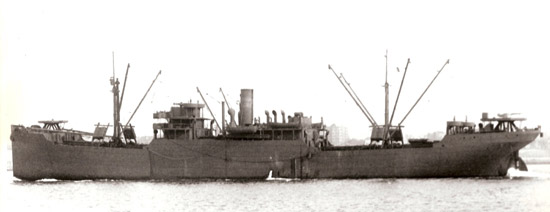
Just over an hour later, at 5:56am, a torpedo struck the West Ivis underneath the stack, and a second torpedo struck in the engine room. The boat broke in half, and within 14 minutes, it sank. The U-boat crew saw lifeboats but did not question (let alone rescue) the stranded crew. The U-boat, U-125, was captained by Ulrich Folkers, a U-boat “ace” who sank 17 allied ships during WWII.
Unescorted merchant ships like the West Ivis were sitting ducks. The West Ivis had nine U.S. Navy guards on board to maintain and operate the boat’s one 4-inch gun, four .50-caliber guns, and four .30-caliber guns. Was there any way these nine guns could pick off an underwater predator like U-125, and in the dark, no less? I think not.
The West Ivis never reached any of its intended destinations—Puerto Rico, Trinidad, Buenos Aires. No radio signals were received, and no trace was found of the ship or its crew. Arvid’s brother Al Berglof, who lived in San Francisco, was listed as Arvid’s next of kin and would have been notified that Arvid was missing and presumed dead. A Swedish friend of Arvid’s named Anders Kruskopf wrote a flowery eulogy for him in Vestkusten, which was a Swedish-language newspaper for ex-pat Swedes in California. Here is the article, dated April 9, 1942, translated from the Swedish:
Arvid Young in Memoriam
Serving in shipping, the lifeblood and artery that nourishes the free nations, stood the sea captain Arvid Young. In the waters where the “vipers” lurked in the Atlantic, his life was sacrificed in this service, when the ship on which he served was swept away. In the “Evening High School of Commerce” in San Francisco, we acquired with him the teachings and ideology of the New World. Even here, Arvid Young revealed a disposition of pure selflessness and always spread a glimmer of pleasure around him. With youthful enthusiasm and joy of work, comforted by his never-failing bright faith in life, he began his career at sea. So he went, this gentle, faithful son of a Swede! When the storms of destruction have subsided, his name will stand indelibly on the list of those who gave their lives for the building of a better world. In his memory, we allow ourselves to quote from Karl David Wirsén:
“… att slunga en tindrande gnista bland världens flämtande irrbloss ut
och tvinga töcknen att brista
och göra på natten ett slut;
att lysa och värma och sträva
och, stupande, ännu en ljusflod stro —
det vore ett liv att leva,
det vore en död att dö!”
(“… to hurl a twinkling spark among the world’s panting flames
and force the mists to burst
and put an end to the night;
to shine and warm and strive
and, falling, another flood of light sprinkle —
it would be a life to live,
it would be a death to die!”)
How it began
From Isak Johansson to Arvid Young: A Swedish immigrant’s tale….
On November 23, 1899, my great-grandmother Johanna Alexandra Johansson gave birth to her tenth and last child, Isak Arvid Johansson. Later, the family changed their last name to Ljung. After emigrating to the U.S., Isak Arvid Ljung became Arvid Ljung, and then Arvid Young.
Isak Arvid was one of my father’s 14 uncles, all of them born and raised in the vicinity of Stensele, Sweden. (For context, all 14 are listed in the table at the bottom of this post.)
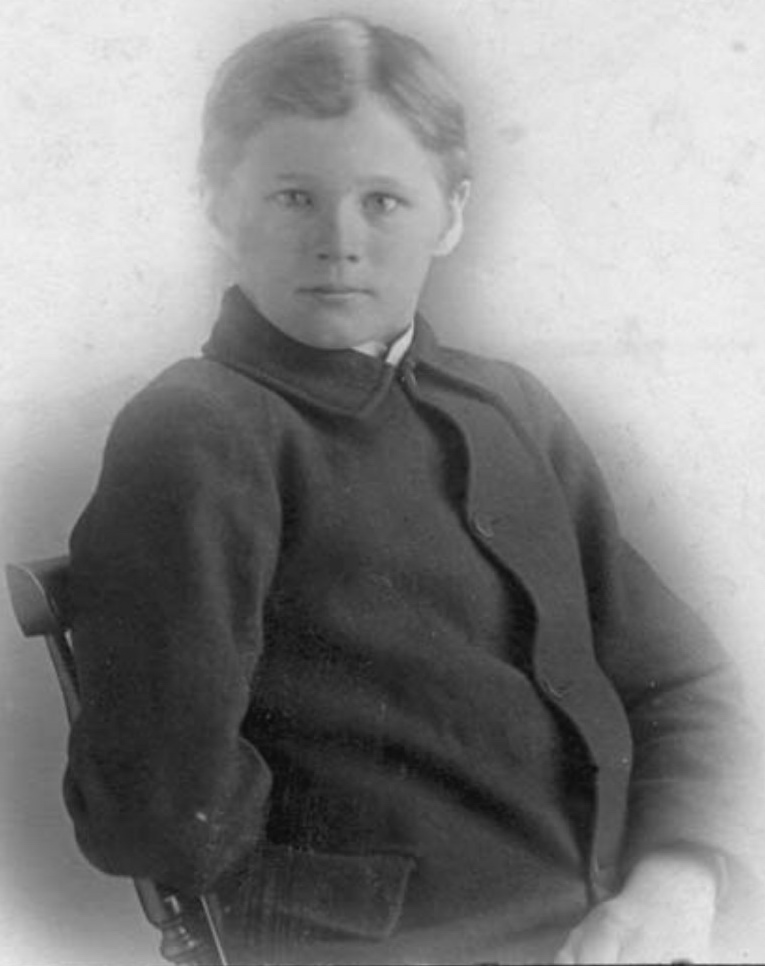
Coming to Amerika
What was Isak Arvid’s youth like in Stensele? We don’t have details. Given what we know of his sister Lilly’s (my grandmother’s) education, he probably received at most an elementary education, and he could read and write. He did not marry. Maybe he worked on the railroad. He grew up in poverty.
The family would have received letters with news from Isak Arvid’s three brothers who had left Sweden: Al Berglof (born Pehr Alfred Johansson), who emigrated to San Francisco in 1896 or 1897; and Viktor and Hugo, who emigrated to Canada in 1902 and 1908, respectively. Their father died in 1922, and the Inland Line of the Swedish railroad was completed all the way to Storuman in 1923.
Maybe all of this contributed to Isak Arvid leaving Stensele in 1924. (The same year my dad was born in Stensele, incidentally.) Isak Arvid travelled to Gothenburg, a journey of over 1,000km, probably by train most of the way. On January 19, 1924, he boarded the first ship to bear the name SS Kungsholm.
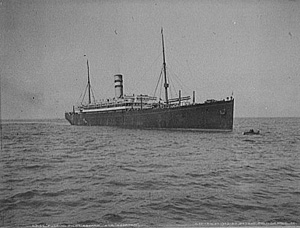
The Kungsholm landed in New York on February 1, 1924, a journey of 14 days. Maybe that’s when Isak Arvid discovered his penchant for the sea? On the New York passenger list for the Kungsholm‘s arrival, he is listed as Isak Arvid Ljung, occupation “railroad worker.” His American contact is his brother Al in San Francisco. Isak Arvid is described as blond, with blue eyes and a fair complexion.
California and the merchant marines
Isak Arvid somehow made his way from New York to San Francisco, and on August 5, 1924, he filed his intention to be naturalized as a U.S. citizen. This document describes him a little differently: Isac with a “c,” brown hair. One imagines a clerk in a hurry.

His occupation is listed as “Bookkeeper”—maybe he helped with the books for Al’s tailoring business?
On June 19, 1925, now going by Arvid Ljung, Arvid graduated from the Lincoln Evening School in San Francisco. (Note that this was not the historic Lincoln school on 5th in San Francisco, because that burned in 1906. Nor was it Lincoln High School, which was established in 1940.)
From 1926 to at least 1930, Arvid’s address was the YMCA at 220 Golden Gate Avenue in San Francisco. He applied for U.S. citizenship in 1930, signing a form stating his intention to “renounce absolutely and forever all allegiance and fidelity to any foreign prince, potentate, state, or sovereignty, and particularly to Gustavus V, King of Sweden.”
While his brother Al clearly helped him get settled, it is not clear whether Arvid lived with Al for any length of time. But Arvid’s 1930 citizenship application lists his address as 109 Buchanan Street in San Francisco—Al’s address.
Somewhere along the line, Arvid became a merchant marine. In 1933, now going by Arvid Young, Arvid applied for a Seaman’s Protection Certificate, a document that identified him and vouched for his U.S. citizenship. In theory, this document would offer protection from “impressment” while at sea. When he applied (August 10, 1933), he listed his last ship as the West Cape, on which he was an able seaman.
At 5′ 5.5″ (1.67 meters) and 147 lbs, Arvid was not a large man. The photo below shows him wearing a suit and tie, but looking relatively unkempt compared to his ever-impeccably dressed and groomed older brother, Al. (More on Uncle Al later.)
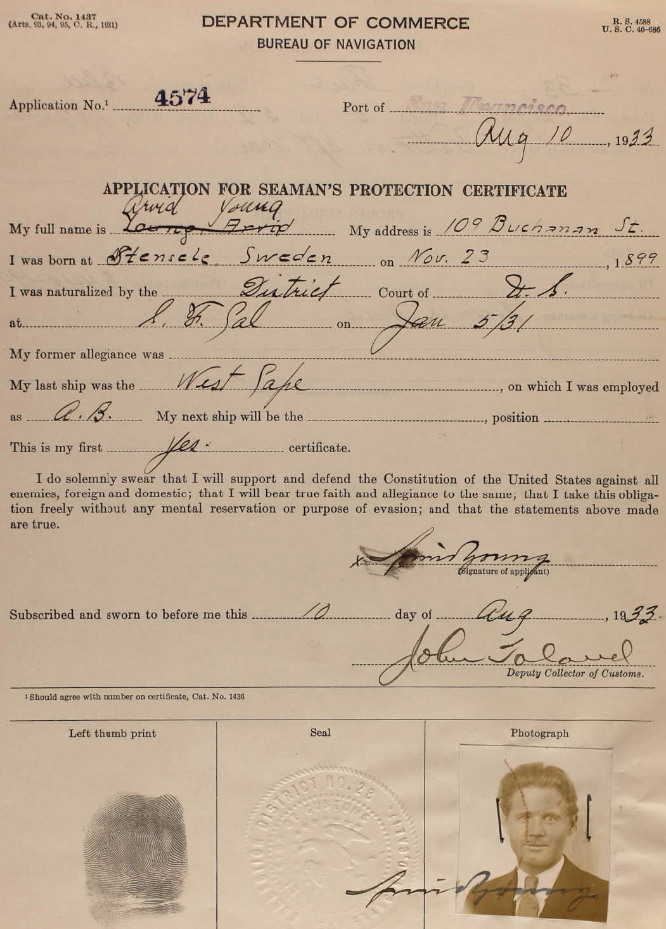
In 1938, Arvid’s brothers Viktor and Hugo visited Arvid and Al in San Francisco, and the reunion of the four brothers from Stensele, Sweden, was written up in Vestkusten newspaper. Before this meeting, the four of them had never been in the same place at the same time.
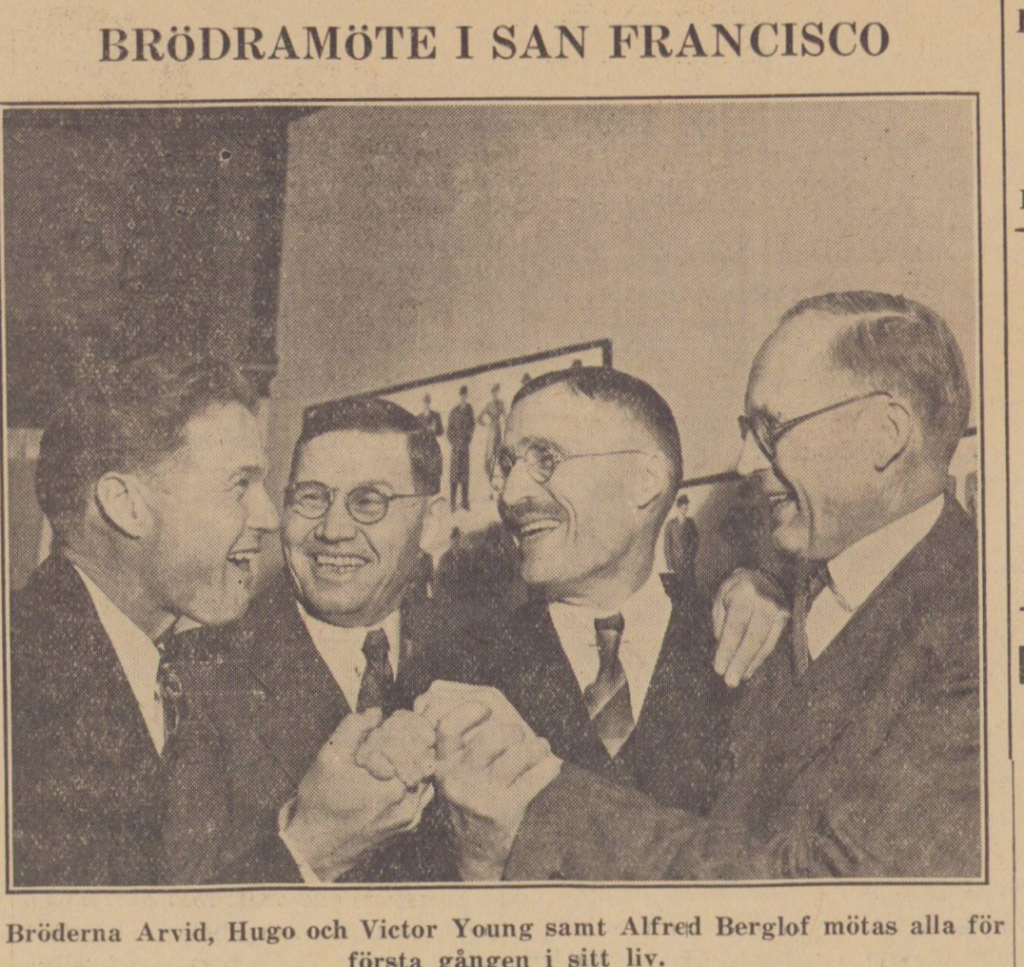
Meanwhile, Arvid’s career as a mariner moved along. In 1939, a local newspaper reported that he was promoted to chief mate, and in 1941 he was promoted to master. He was at sea a lot, and his YMCA address might have been his permanent address for collecting mail.
In 1939, Arvid’s mother died. Three years later, Arvid died. It would have taken time for the news to reach his siblings in Canada and Sweden, all of whom were still living. His eldest brother, Johan, was 67 at the time.
Which brings us back to how it ended….
It seems likely that some men died immediately when the torpedoes struck the West Ivis on January 26, 1942, but we know that some made it into lifeboats. Was Arvid one of them? And if so, how did he die? It is not a pleasant thought. The only one of my father’s 14 uncles to die younger than Arvid was my grandfather’s brother Sören, who died in 1919 at the age of 12.
Arvid among the uncles
And finally, for the sake of context, let us enumerate my dad’s many uncles, shall we? Last names that they chose in adulthood are shown in parentheses.
| Dates (age at death) | Bros. of Fritz Johansson (Stenstedt) 1893–1963 (70) | Bros. of Lilly Ljung 1894–1977 (83) |
| 1874–1949 (75) | Johan Ljung | |
| 1877–1972 (95) | Pehr Alfred Ljung (Berglof) | |
| 1879–1969 (90) | Viktor Ljung (Young) | |
| 1887–1963 (76) | Axel Ljung | |
| 1890–1962 (71) | Hugo Ljung (Young) | |
| 1895–1949 (54) | Robert Johansson | |
| 1898–1948 (49) | Aron Johansson | |
| 1899–1961 (61) | Per Hugo Johansson | |
| 1899–1942 (42) | Isak Arvid Ljung (Young) | |
| 1902–1967 (64) | Johan Johansson | |
| 1903–1956 (52) | Gustav Johansson (Elke) | |
| 1906–1991 (85) | Knut Johansson (Fällstam) | |
| 1907–1919 (12) | Sören Johansson | |
| 1911–1965 (54) | Karl Johansson |
Note how (relatively) young most of my dad’s paternal uncles were when they died. Only Knut made it past 70. Something to explore in another post….
References
uboat.net, “Ships hit by U-boats: West Ivis,” https://uboat.net/allies/merchants/ship/1296.html, accessed Dec. 21, 2024.
Find a Grave, “Isak Arvid Young,” https://www.findagrave.com/memorial/86282231/arvid_isak-young, accessed Dec. 21, 2024.
Wikipedia, “Swedish American Line,” https://en.wikipedia.org/wiki/Swedish_American_Line, accessed Dec. 21, 2024.
Gotherburg, Sweden, Passenger Lists 1869-1951; New York Passenger Lists, 1820-1957.
Swedish Wikipedia, “Inlandsbanan (Inland Railway),” https://sv.wikipedia.org/wiki/Inlandsbanan, accessed Dec. 21, 2024.

You must be logged in to post a comment.